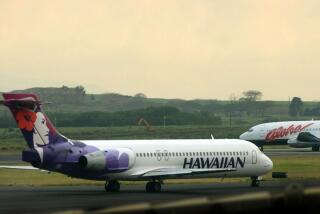Dymally Tops State’s House Delegation in Travel, Study Reveals
- Share via
WASHINGTON — Rep. Mervyn M. Dymally (D-Compton), who is fast becoming California’s most well-traveled congressman, made eight separate foreign trips at the expense of the U.S. government and six overseas visits financed by special interests or foreign governments during the 100th Congress in 1987 and 1988.
Although Dymally had already reported his privately funded trips earlier this year, the extent of his government-financed travel did not come to light until Wednesday with the publication of a comprehensive study of congressional travel by Public Citizen, a nonprofit organization founded by consumer advocate Ralph Nader.
Picked Up Tab
The study indicates that taxpayers picked up the tab for a total of 1,053 congressional trips during the two-year session of the 100th Congress at a cost of more than $13.5 million. This included one trip sponsored by the House Rules Committee, which has no jurisdiction over foreign or domestic policy issues.
While Dymally’s jet-setting clearly outpaced other California congressmen, he was by no means the leader in congressional travel funded by the U.S. taxpayer. That status went to Rep. Stephen Solarz (D-N.Y.), chairman of the House Asian and Pacific subcommittee, who made 14 separate trips--with 39 stops--paid for by the government.
Nevertheless, Dymally’s government-funded travel exceeded that of most congressmen. His itinerary included trips to France and the United Kingdom at a cost of $5,425; Zaire, Belgium, Israel, Jordan and Saudi Arabia, $4,741; Japan, Korea, Taiwan, Singapore and China, $6,875; Antigua, $1,474; Trinidad, Barbados and St. Lucia, $1,383; United Kingdom, Ethiopia, Angola and Portugal, $6,744, and Brazil for an undetermined cost.
Dymally is a member of Solarz’s subcommittee on Asian and Pacific affairs.
Dymally’s privately funded travel drew attention recently as a result of his efforts to persuade the government of Uganda to hire a friend and campaign contributor, Mamadi Diane, as an agent for U.S. food aid sent to that country. Diane, who heads the Zaire-American Research Institute, accompanied Dymally last year on one of his two trips to Zaire.
In January, 1988, while Dymally was traveling to Zaire, Belgium, Israel, Jordan and Saudi Arabia at U.S. government expense, he also made stops in Zambia, Gabon, the Ivory Cost, Angola and Ghana at the expense of the governments of Zaire and the Ivory Coast and a group known as the Coalition for a Free Africa.
Dymally also traveled to the West Bank and the Gaza Strip in the Middle East at the expense of the Arab American Institute, to Brazil at the expense of the Coalition for a Free Africa, to Puerto Rico at the expense of the private Mendez Foundation, to Tokyo and Seoul at the expense of Soka University, to Saudi Arabia at the expense of the International Friendship Assn. and from Nice, France, to Brussels to Zaire at the expense of the government of Zaire.
Other well-traveled Californians included recently retired Rep. Robert Badham, who took seven U.S.-funded overseas trips; Rep. George E. Brown (D-Colton), who took six, and Reps. Robert Dornan (R-Garden Grove) and Howard Berman (D-Panorama City), each of whom took five foreign trips financed by the taxpayers.
Another Californian, Rep. George Miller (D-Martinez), took part in one of the most expensive government-paid trips during the 100th Congress, at least on the basis of cost per person. Miller was one of several House members who took an eight-day trip to Korea, Taiwan and Hong Kong in November, 1988, at a cost of $21,315 each.
It is not always clear from available public records which government-funded trips by members of Congress were made for legislative research and which trips had no legislative purpose. But Public Citizen singled out the House Rules Committee’s 12-day trip to Spain, Malta, Turkey, Kenya and Senegal as the most obvious “junket.”
The Rules Committee listed as the objective of its trip “to acquaint members with various international issues as they relate to the foreign policy of the United States and to geopolitical issues which will affect international relations.” Among other stops, the group listed a meeting with the Malta parliamentary secretary for the elderly at the U.N. International Institute for the Aging.
Mark Centennial
Likewise, 12 congressmen and seven staff members went on a seven-day trip to Australia in August, 1988, to help celebrate the centennial of the Australian Parliament. The total reported cost for the trip was $188,266.
Members of Congress sometimes underestimate the full cost of their trips when they submit the final report to be printed in the Congressional Record, according to Public Citizen.
In July, 1988, for example, two congressmen and two staffers made a trip to the Philippines, Korea and Japan that they reported as costing $21,197. But U.S. Army documents for the same trip list the total cost of military aircraft used at $101,926.
Although some congressmen travel overseas on commercial airlines, most of them prefer to go by military transport. The Air Force’s 89th Military Airlift Wing has been been set aside for ferrying members of Congress and other high-ranking officials around the world. The wing has more than 1,400 personnel and 45 aircraft, but its annual budget is not public.
Members of Congress are permitted to take spouses along on the trips as long as it creates no additional expense to the government. In practice, spouses usually travel free, occupying empty seats on military aircraft chartered for members.
More to Read
Get the L.A. Times Politics newsletter
Deeply reported insights into legislation, politics and policy from Sacramento, Washington and beyond. In your inbox twice per week.
You may occasionally receive promotional content from the Los Angeles Times.










